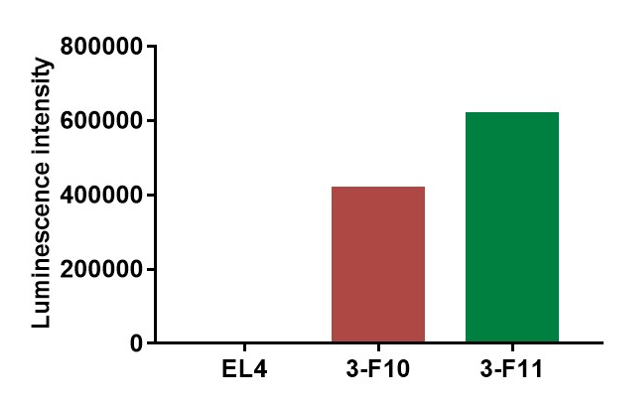Basic Information
Description
The mouse Ccr4 gene was replaced by human CCR4 coding sequence and the luciferase sequence in B-hCCR4-luc EL4 cells. Human CCR4 is highly expressed on the surface of B-hCCR4-luc EL4 cells.
-
Gene Targeting Strategy

-
Gene targeting strategy for B-hCCR4-luc EL4 cells.
The exogenous promoter and human CCR4 coding sequence and the luciferase sequence were inserted to replace part of murine exon 2. The insertion disrupts the endogenous murine Ccr4 gene, resulting in a non-functional transcript.
-
Protein Expression Analysis

-

CCR4 expression analysis in B-hCCR4-luc EL4 cells by flow cytometry.
Single cell suspensions from wild-type EL4 and B-hCCR4-luc EL4 cultures were stained with species-specific anti-CCR4 antibody. Human CCR4-luc was detected on the surface of B-hCCR4-luc EL4 cells but not wild-type EL4 cells. The clones 3-F10 and 3-F11 of B-hCCR4-luc EL4 cells were used for in vivo tumor growth assays.
-
The Luminescence Signal Intensity Analysis

-

The luminescence signal intensity of B-hCCR4-luc EL4 cells.
The luminescence intensity was detected by Bright-GloTM luciferase Assay System (Promega, Cat E2610), and The clones 3-F10 and 3-F11 of B-hCCR4-luc EL4 cells has strong luminescence signal.
-
Tumor Growth Curve

-

Subcutaneous homograft tumor growth of B-hCCR4-luc EL4 cells.
B-hCCR4-luc EL4 cells (2×105) and wild-type EL4 cells (2×105) were subcutaneously implanted into C57BL/6 mice (female, 7-week-old, n=5). Tumor volume and body weight were measured twice a week. (A) Average tumor volume ± SEM. (B) Body weight (Mean± SEM). Volume was expressed in mm3 using the formula: V=0.5 X long diameter X short diameter2. As shown in panel A, B-hCCR4-luc EL4 cells were able to form tumors in vivo and can be used for efficacy studies.
-
Protein expression analysis of tumor cells

-

B-hCCR4-luc EL4 cells were subcutaneously transplanted into C57BL/6 mice (n=5). At the end of the experiment, tumor cells were harvested and assessed for human CCR4 expression by flow cytometry. As shown, human CCR4 was highly expressed on the surface of tumor cells. Therefore, B-hCCR4-luc EL4 cells can be used for in vivo efficacy studies of CCR4 therapeutics.
-
Quantitative imaging data & Body weight changes

-

Tumor growth and in vivo imaging of B-hCCR4-luc EL4 cells. B-hCCR4-luc EL4 cells (2×105) were injected into the tail vein of wild-type C57BL/6 mice. Signal intensity and body weight were measured twice a week. (A) Imaging was performed twice a week. (B) Body weight (Mean ± SEM). B-hCCR4-luc EL4 cells can be used for in vivo efficacy evaluation.


